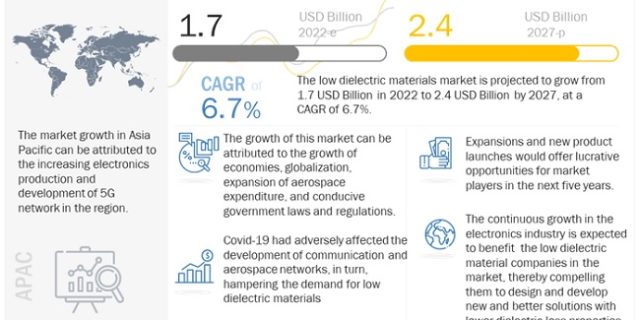
In terms of value, the global low dielectric materials market size is projected to grow from USD 1.7 Billion in 2022 to reach USD 2.4 billion by 2027, at a CAGR of 6.7%. The market is expected to witness modest growth during the forecast period primarily due to the increasing investments in R&D of 5G communication devices and network development activities by private organizations and governments of developed and developing nations and growing demand for VLSI-based microelectronics for manufacturing of IoT based smart devices. Low dielectric materials have high demand from the electronics and aerospace industries. The market is classified based on type, material type, application, and region.
Thermoset resin is the fastest-growing type in the overall market. As thermoset resins offer excellent strength, toughness, and high heat resistance, they have gained significant impetus in manufacturing electronics and aerospace solutions, leading to them growing at a swift rate in the global market. They are used in large quantities for various applications, including spacecrafts, aircrafts, missiles, antennae, radomes, microelectronics, and microwave products. The other types of low dielectric materials include thermoplastic resins and ceramics. These materials are primarily employed for the manufacturing of PCBs and microelectronics, respectively.
Download PDF Brochure @ https://www.marketsandmarkets.com/pdfdownloadNew.asp?id=60727102
The utilization of low dielectrics in manufacturing of PCBs is gaining immense traction in accordance with the development of 5G communication network across the developed and developing countries. Low dielectric materials reduces the signal loss at high frequencies, which make them material of choice for the manufacturing of flexible printed boards (FPCs). Moreover, as these materials transmit energy without loss, heat generation is lowered, which helps OEM manufacturers efficiently manage heat flow in their devices, leading to higher uptake of these materials for PCB manufacturing. On the other hand, communication plays a critical role in the smooth operations of spacecraft, airplanes, and satellites. Any loss in communication could lead to drastic consequences; therefore, low dielectric materials are used by companies for development of radomes and antennae.
Speak to our Analyst @ https://www.marketsandmarkets.com/speaktoanalystNew.asp?id=60727102
Asia Pacific, the hub of electronics manufacturing, currently leads to the demand for low dielectric materials. Key companies manufacturing 5G-based mobile devices, smart electronics, and wires have their base in Asian countries such as Japan, Taiwan, South Korea, and China. With India and South-east Asian nations jumping in the race of development of 5G network, the demand is expected to further inflate in the region. Also, the regional supremacy race between China and India is expected to accentuate the demand for aerospace and automotive solutions in the region, leading to be a key reason behind the growth of the global market during the forecast years.
Read More @ https://www.marketsandmarkets.com/ResearchInsight/low-dielectric-materials-market.asp

